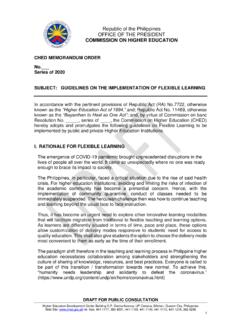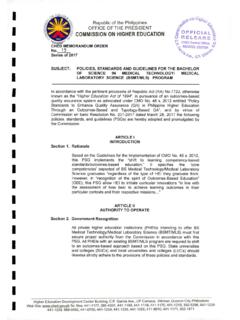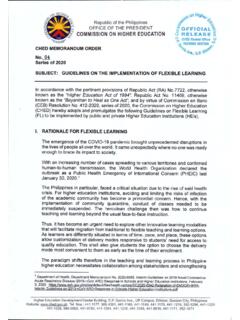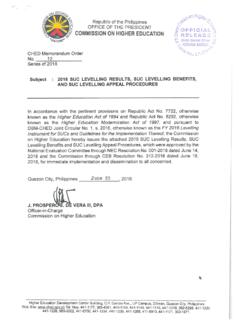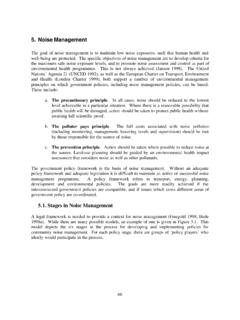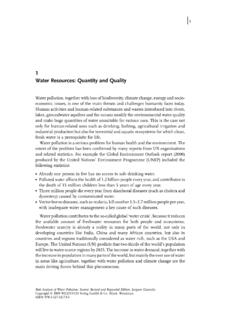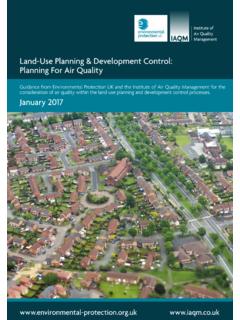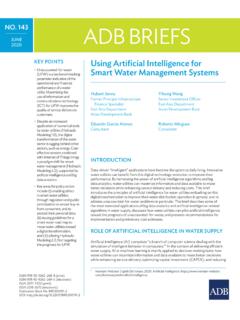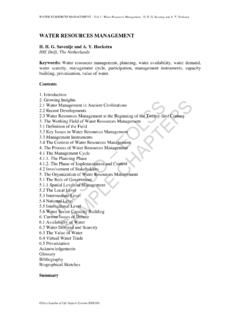Transcription of known as “SUCs Land Use Development and Infrastructure ...
1 1 Implementing Rules and Regulations of Republic Act No. 11396, 2 known as SUCs land Use Development and Infrastructure Plan 3 (LUDIP) Act . 4. 5 Pursuant to Section 7 of Republic Act No. 11396, otherwise known as SUCs land Use 6 Development and Infrastructure Plan (LUDIP) Act, the Commission on Higher Education 7 hereby formulates and adopts the following rules and regulations: 8. 9 RULE I. 10 GENERAL PROVISIONS. 11. 12 Section 1. Title. These rules and regulations shall be known as the Implementing Rules and 13 Regulations of Republic Act No. 11396, known as SUCs land Use Development and 14 Infrastructure Plan (LUDIP) Act, and shall be collectively known as the Rules. 15. 16 Section 2. Purpose. These Rules are formulated and adopted to prescribe the procedures and 17 guidelines for the implementation of the SUCs land Use Development and Infrastructure 18 Plan (LUDIP) Act" in order to facilitate compliance therewith and achieve the objectives 19 thereof.
2 20. 21 Section 3. Declaration of Policy. The Rules enforces the intentions of the Act to provide for 22 a rational, holistic, efficient and just allocation, utilization, Development and management of 23 the country's land and water resources that is consistent with the principles of equity, social 24 justice, environmental integrity and sustainable Development for the common good. 25. 26 Section 4. Definition of Terms. For purposes of these Rules, the following definitions will 27 apply: 28. 29 Ancestral Domain refers to all areas generally belonging to Indigenous Cultural 30 Communities/ Indigenous Peoples (ICCs/IPs) comprising lands, inland waters, coastal 31 areas, and natural resources therein, held under a claim of ownership, occupied or 32 possessed by ICCs/IPs, by themselves or through their ancestors, communally or 33 individually since time immemorial, continuously to the present except when Page 1 | 21.
3 34 interrupted by war, force majeure or displacement by force, deceit, stealth or as a 35 consequence of government projects or any other voluntary dealings entered into by 36 government and private individuals/corporations, and which are necessary to ensure 37 their economic, social and cultural welfare. It shall include ancestral lands, forests, 38 pasture, residential, agricultural, and other lands individually owned whether alienable 39 and disposable or otherwise, hunting grounds, burial grounds, worship areas, bodies 40 of water, mineral and other natural resources, and lands which may no longer be 41 exclusively occupied by ICCs/IPs but from which they traditionally had access to for 42 their subsistence and traditional activities, particularly the home ranges of ICCs/IPs 43 who are still nomadic and/or shifting cultivators. 44. 45 Branch or Campus refers to an educational facility, which are units that are 46 geographically separated or detached from the main campus of the college or 47 university and has its own educational facilities, administrative and faculty 48 complement, and program offerings.
4 49. 50 Cadastral Survey refers to the act of subdividing land into parcels for ownership under 51 a land title and to re-establish boundaries of previously surveyed properties to 52 determine the physical extent of ownership or to facilitate the transfer of the property 53 title. 54. 55 Campus Master Plan refers to a campus-specific policy document that defines the 56 academic, academic-support and administrative needs of the campus and its translation 57 into land uses and Development plans consistent and in compliance with the SUC. 58 Strategic Plan and the SUC Development Principles and Design Guidelines, for the 59 Development of the real estate properties assigned to the campus. It is composed of: 60 a. Campus land use plan 61 b. Campus master Development plan 62 c. Site Development plan for each campus land use cluster 63 Climate change refers to a change in climate that can be identified by changes in the 64 mean and/or variability of its properties and that persists for an extended period, Page 2 | 21.
5 65 typically decades or longer, whether due to natural variability or as a result of human 66 activity. 67. 68 Community land Use refers to an official designation of specific types of activity 69 and coverage on a land surface area. 70. 71 Comprehensive land Use Plan refers to the document, formulated by the local 72 government in consultation with its stakeholders, that defines or provides guidelines 73 on the allocation, utilization, Development and management of all lands, within a given 74 territory or jurisdiction, including municipal waters, according to the inherent qualities 75 of the land itself and supportive economic, demographic, sociocultural and 76 environmental objectives. 77. 78 Extension Class refers to a class normally offered by a SUC in its main campus but 79 is conducted in another location with the approval of the governing board and 80 attestation from the CHED as compliant to its requirements.
6 81. 82 Extension Program refers to a set of projects that aim to communicate and transfer 83 knowledge and technology to specific sectors and target clienteles (as distinguished 84 from those enrolled in formal degree programs and course offerings) to enable them 85 to effectively improve production in community and/or institutions and the quality of 86 life, at the same time enhance the SUCs' academic and research programs. 87. 88 Hazards refers to a potentially damaging physical event, phenomenon or human 89 activity that may cause the loss of life or injury, property damage, social and economic 90 disruption or environmental degradation. Hazards can include latent conditions that 91 may represent future threats and can have different origins: natural (geological, 92 hydrometeorological and biological) or induced by human processes (environmental 93 degradation and technological hazards). Hazards can be single, sequential or 94 combined in their origin and effects.
7 Each hazard is characterized by its location, 95 intensity, frequency and probability. 96. 97 Hydrometeorological hazards refers to natural processes or phenomena of 98 atmospheric, hydrological or oceanographic nature, which may cause the loss of life Page 3 | 21. 99 or injury, property damage, social and economic disruption or environmental 100 degradation. Hydrometeorological hazards include floods, debris and mud floods;. 101 tropical cyclones, storm surges, thunder/hailstorms, rain and wind storms, blizzards 102 and other severe storms; drought, desertification, wildland fires, temperature extremes, 103 sand or dust storms. 104. 105 Idle land refers to a recognized land asset of a SUC on which it has made no 106 improvements, as certified by the city, municipal or provincial assessor. 107. 108 Indigenous Cultural Communities/ Indigenous Peoples (ICCs/IPs) refers to a 109 group of people or homogenous societies identified by self- ascription and ascription 110 by others, who have continuously lived as organized community on communally 111 bounded and defined territory, and who have, under claims of ownership since time 112 immemorial, occupied, possessed and utilized such territories, sharing common bonds 113 of language, customs, traditions and other distinctive cultural traits, or who have, 114 through resistance to political, social and cultural inroads of colonization, non- 115 indigenous religions and cultures, became historically differentiated from the majority 116 of Filipinos.
8 ICCs/IPs shall likewise include peoples who are regarded as indigenous 117 on account of their descent from the populations which inhabited the country, at the 118 time of conquest or colonization, or at the time of inroads of non-indigenous religions 119 and cultures, or the establishment of present state boundaries, who retain some or all 120 of their own social, economic, cultural and political institutions, but who may have 121 been displaced from their traditional domains or who may have resettled outside their 122 ancestral domains. 123. 124 Indigenous Knowledge Systems and Practices (IKSPs) refer to systems, 125 institutions, mechanisms, and technologies comprising a unique body of knowledge 126 evolved through time that embody patterns of relationships between and among 127 peoples and between peoples, their lands and resource environment, including such 128 spheres of relationships which may include social, political, cultural, economic, 129 religious spheres, and which are the direct outcome of the indigenous peoples, 130 responses to certain needs consisting of adaptive mechanisms which have allowed 131 indigenous peoples to survive and thrive within their given socio-cultural and 132 biophysical conditions.
9 Page 4 | 21. 133. 134 Infrastructure plan refers to a plan of SUCs which focuses on the construction of 135 buildings, transportation network, public utility systems such as water supply, power, 136 communication and other Infrastructure facilities such as flood control, irrigation 137 system, etc. that are required to realize the mission, vision, goals and objectives of the 138 SUCs. 139. 140 Infrastructure Project refers to the construction, improvement, rehabilitation, 141 restoration or major maintenance of roads and bridges, railways, airports, seaports, 142 communication facilities, civil works components of information technology projects, 143 irrigation, flood control and drainage, water supply, sanitation, sewerage and solid 144 waste management systems, shore protection, energy/ power and electrification 145 facilities, national buildings, school buildings, hospital buildings and other related 146 construction project of the government.
10 147. 148 land use refers to the manner of utilizing the land , including its allocation, 149 Development and management. 150. 151 land use planning refers to the branch of physical and socio-economic planning 152 that determines the means and assesses the values or limitations of various options in 153 which land is to be utilized, with the corresponding effects on different segments of 154 the population or interests of a community taken into account in resulting decisions. 155. 156 land -use planning involves studies and mapping, analysis of environmental and 157 hazard data, formulation of alternative land -use decisions and design of a long-range 158 plan for different geographical and administrative scales. 159. 160 Operationally, it is the process undertaken by public authorities to identify, evaluate 161 and decide on different options for the use of land , including consideration of long- 162 term economic, social and environmental objectives and the implications for different 163 communities and interest groups, and the subsequent formulation and promulgation of 164 plans that describe the permitted or acceptable uses.
